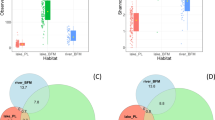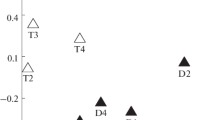Abstract
Eukaryotic plankton assemblages in 11 high-mountain lakes located at altitudes of 2,817 to 5,134 m and over a total area of ca. one million square kilometers on the Eastern Tibet Plateau, spanning a salinity gradient from 0.2 (freshwater) to 187.1 g l−1 (hypersaline), were investigated by cultivation independent methods. Two 18S rRNA gene-based fingerprint approaches, i.e., the terminal restriction fragment length polymorphism and denaturing gradient gel electrophoresis (DGGE) with subsequent band sequencing were applied. Samples of the same lake type (e.g., freshwater) generally shared more of the same bands or T-RFs than samples of different types (e.g., freshwater versus saline). However, a certain number of bands or T-RFs among the samples within each lake were distinct, indicating the potential presence of significant genetic diversity within each lake. PCA indicated that the most significant environmental gradient among the investigated lakes was salinity. The observed molecular profiles could be further explained (17–24%) by ion percentage of chloride, carbonate and bicarbonate, and sulfate, which were also covaried with change of altitude and latitude. Sequence analysis of selected major DGGE bands revealed many sequences (largely protist) that are not related to any known cultures but to uncultured eukaryotic picoplankton and unidentified eukaryotes. One fourth of the retrieved sequences showed ≤97% similarity to the closest sequences in the GenBank. Sequences related to well-known heterotrophic nanoflagellates were not retrieved from the DGGE gels. Several groups of eukaryotic plankton, which were found worldwide and detected in low land lakes, were also detected in habitats located above 4,400 m, suggesting a cosmopolitan distribution of these phylotypes. Collectively, our study suggests that there was a high beta-diversity of eukaryotic plankton assemblages in the investigated Tibetan lakes shaped by multiple geographic and environmental factors.




Similar content being viewed by others
References
Abdo Z, Schuette UME, Bent SJ, Williams CJ, Forney LJ, Paul J (2006) Statistical methods for characterizing diversity of microbial communities by analysis of terminal restriction fragment length polymorphisms of 16S rRNA genes. Environ Microbiol 8:929–938
Auguet JC, Casamayor EO (2008) A hotspot for cold crenarchaeota in the neuston of high mountain lakes. Environ Microbiol 10:1080–1086
Berninger UG, Finlay B, Kuuppo-Leinikki P (1991) Protozoan control of bacterial abundances in freshwater. Limnol Oceanogr 36:139–146
Blumthaler M, Ambach W, Ellinger R (1997) Increase in solar UV radiation with altitude. J Photochem Photobiol B 39:130–134
Boenigk J, Jost S, Stoeck T, Garstecki T (2007) Differential thermal adaptation of clonal strains of a protist morphospecies originating from different climatic zones. Environ Microbiol 9:593–602
Boenigk J, Pfandl K, Garstecki T, Harms H, Novarino G, Chatzinotas A (2006) Evidence for geographic isolation and signs of endemism within a protistan morphospecies. Appl Environ Microbiol 72:5159–5164
Bowman TE (1986) Freshwater calanoid copepods of the West Indies. Syllogeus 58:237–246
Caron DA (2005) Introductory remarks: advances in the molecular ecology of protists. J Eukaryot Microbiol 52:81–82
Caron DA, Gast RJ, Lim EL, Dennett MR (1999) Protistan community structure: molecular approaches for answering ecological questions. Hydrobiologia 401:215–227
Casamayor EO, Massana R, Benlloch S, Øvreas L, Diez B, Goddard VJ, Gasol JM, Join I, Rodriguez-Valera F, Pedros-Alio C (2002) Changes in archaeal, bacterial and eukaryal assemblages along a salinity gradient by comparison of genetic fingerprinting methods in a multi-pond solar saltern. Environ Microbiol 4:338–348
Cervantez-Martínez A, Elias-Gutierrez M, Gutierrez-Aguirre MA, Kotov AA (2005) Ecological remarks on Mastigodiaptomus nesus Bowman, 1986(Copepoda: Calanoida) in a Mexican karstic sinkhole. Hydrobiologia 542:95–102
Countway PD, Gast RJ, Dennett MR, Savai P, Rose JM, Caron DA (2007) Distinct protistan assemblages characterize the euphotic zone and deep sea (2500 m) of the western North Atlantic (Sargasso Sea and Gulf Stream). Environ Microbiol 9:1219–32
Countway PD, Gast RJ, Savai P, Caron DA (2005) Protistan diversity estimates based on 18S rDNA from seawater incubations in the Western North Atlantic. J Eukaryot Microbiol 52:95–106
Diez B, Pedros-Alio C, Marsh TL, Massana R (2001) Application of denaturing gradient gel electrophoresis (DGGE) to study the diversity of marine picoeukaryotic assemblages and comparison of DGGE with other molecular techniques. Appl Environ Microbiol 67:2942–2951
Diez B, Pedros-Alio C, Massana R (2001) Study of genetic diversity of eukaryotic picoplankton in different oceanic regions by small-subunit rRNA gene cloning and sequencing. Appl Environ Microbiol 67:2932–2941
Elwood HJ, Olsen GJ, Sogin ML (1985) The small-subunit ribosomal RNA gene sequences from the hypotrichous ciliates Oxytricha nova and Stylonychia pustulata. Mol Biol Evol 2:399–410
Fawley MJ, Fawley KP, Buchheim MA (2004) Molecular diversity among communities of freshwater Microchlorophytes. Microb Ecol 48:489–499
Gast RJ, Dennett MR, Caron DA (2004) Characterization of protistan assemblages in the Ross Sea, Antarctica, by denaturing gradient gel electrophoresis. Appl Environ Microbiol 70:2028–2037
Greenberg AE, Clesceri LS, Eaton AD (1992) Standard methods for the examination of water and wastewater. American Public Health Association, Washington
Ihaka R, Gentleman R (1996) R: A Language for Data Analysis and Graphics. J Comput Graph Stat 5:299–314
Jones BE, Grant WD, Duckworth AW, Owenson GG (1998) Microbial diversity of soda lakes. Extremephiles 2:191–200
Lara E, Berney C, Harms H, Chatzinotas A (2007) Cultivation-independent analysis reveals a shift in ciliate 18S rRNA gene diversity in a polycyclic aromatic hydrocarbon polluted soil. FEMS Microbiol Ecol 62:365–373
Lefranc M, Thenot A, Lepere C, Debroas D (2005) Genetic diversity of small eukaryotes in lakes differing by their trophic status. Appl Environ Microbiol 71:5935–5942
Lepère C, Boucher D, Jardillier L, Domaizon I, Debroas D (2006) Succession and regulation factors of small eukaryote community composition in a lacustrine ecosystem (Lake Pavin) Appl. Envir Microbiol 2006(72):2971–2981
Lim EL, Dennett MR, Caron DA (2001) Molecular identification of heterotrophic nanoflagellates by restriction fragment length polymorphism analysis of small subunit ribosomal DNA. J Eukaryot Microbiol 48:247–257
Liu WT, Marsh TL, Cheng H, Forney LJ (1997) Characterization of microbial diversity by determining terminal restriction fragment length polymorphisms of genes encoding 16S rRNA. Appl Environ Microbiol 63:4516–4522
Logares R, Daugbjerg N, Boltovskoy A, Kremp A, Laybourn-Parry J, Rengefors K (2008) Recent evolutionary diversification of a protist lineage. Environ Microbiol 10:1231–1243
Long EO, Dawid IB (1980) Repeated genes in eukaryotes. Annu Rev Biochem 49:727–764
Lopez-Garcia P, Rodriquez-Valera F, Pedros-Alio C, Moreira D (2001) Unexpected diversity of small eukaryotes in deep sea Antarctic plankton. Nature 409:603–607
Ludwig W, Strunk O, Westram R, Richter L, Meier H, Yadhukumar, Buchner A, Lai T, Steppi S, Jobb G, Forster W, Brettske I, Gerber S, Ginhart AW, Gross O, Grumann S, Hermann S, Jost R, Konig A, Liss T, Lussmann R, May M, Nonhoff B, Reichel B, Strehlow R, Stamatakis A, Stuckmann N, Vilbig A, Lenke M, Ludwig T, Bode A, Schleifer KH (2004) ARB: a software environment for sequence data. Nucleic Acids Res 32:1363–1371
Ma YH, Zhang WZ, Xue YF, Zhou PJ, Ventosa A, Grant WD (2004) Bacterial diversity of the Inner Mongolian Baer Soda Lake as revealed by 16S rRNA gene sequence analyses. Extremephiles 8:45–51
Massana R, Balague V, Guillou L, Pedros-Alio C (2004) Picoeukaryotic diversity in an oligotrophic coastal site studied by molecular and culturing approaches, FEMS Microbiol. Ecol 50:231–243
Massana R, Guillou L, Díez B, Pedro´s-Alio C (2002) Unveiling the organisms behind novel eukaryotic ribosomal DNA sequences from the ocean. Appl Environ Microbiol 68:4554–4558
Maturrano L, Santos F, Rossello-Mora R, Anton J (2006) Microbial diversity in Maras salterns, a hypersaline environment in the Peruvian Andes. Appl Environ Microbiol 72:3887–3895
Moon-van der Staay SY, Wachter RD, Vaulot D (2001) Oceanic 18S rDNA sequences from picoplankton reveal unexpected eukaryotic diversity. Nature 409:607–610
Muyzer G, Brinkhoff T, Nübel U, Santegoeds C, Schäfer H, Wawer C (1998) Denaturing gradient gel electrophoresis (DGGE) in microbial ecology. p. 1–27. In: Akkermans ADL, van Elsas JD, de Bruijn FJ (eds) Molecular microbial ecology manual. Kluwer, Dordrecht
Pedrós-Alió C, Calderón-Paz JI, MacLean MH, Medina G, Marrasé C, Gasol JM, Guixa-Boixereu N (2000) The microbial food web along salinity gradients. FEMS Microbiol Ecol 32:143–155
Pérez MT, Sommaruga R (2007) Interactive effects of solar radiation and dissolved organic matter on bacterial activity and community structure. Environ Microbiol 9:2200–2210
Porter KG, Feig YS (1980) The use of DAPI for identifying and counting aquatic microflora. Limnol Oceanogr 25:943–947
Richards TA, Vepritskiy AA, Gouliamova DE, Nierzwicki-Bauer SA (2005) The molecular diversity of freshwater picoeukaryotes from an oligotrophic lake reveals diverse, distinctive and globally dispersed lineages. Environ Microbiol 7:1413–1425
Schabereiter-Gurtner C, Pinar G, Lubitz W, Rolleke S (2001) Analysis of fungal communities on historical church window glass by denaturing gradient gel electrophoresis and phylogenetic 18S rDNA sequence analysis. J Microbiol Methods 47:345–354
Slapeta J, Moreira D, Lopez-Garcia P (2005) The extent of protist diversity: insights from molecular ecology of freshwater eukaryotes. Proc R Soc Ser B 272:2073–2081
Sommaruga R (2001) The role of solar UV radiation in the ecology of alpine lakes. J Photochem Photobiol 62:35–42
Sommaruga R, Oberleiter A, Psenner R (1996) Effect of UV radiation on the bacterivory of a heterotrophic nanoflagellate. Appl Environ Microbiol 62:4395–4400
Suarez-Morales E, Reid JW, Fiers F, Iliffe TM (2004) Historical biogeography and distribution of the freshwater cyclopine copepods (Copepoda, Cyclopoida, Cyclopinae) of the Yucatan Peninsula, Mexico. J Biogeogr 31:1051–1063
ter Braak CJF, Verdonschot PFM (1995) Canonical correspondence analysis and related multivariate methods in aquatic ecology. Aquat Sci 57:255–289
Thum RA (2004) Using 18S rDNA to resolve diaptomid copepod (Copepoda: Calanoida: Diaptomidae) phylogeny: an example with the North American genera. Hydrobiologia 519:135–141
Van Hannen EJ, Van Agterveld MP, Gons HJ, Laanbroek HJ (1998) Revealing genetic diversity of eukaryotic microorganisms in aquatic environments by denaturing gradient gel electrophoresis. J Phycol 34:206–213
Vinebrooke RD, Leavitt PR (1999) Differential responses of littoral communities to ultraviolet radiation in an alpine lake. Ecology 80:223–237
Wang S, Dou H (1998) Lakes in China. Science, Beijing
Weisse T (2003) Pelagic microbes—Protozoa and the microbial food web. In: O’Sulliva PE, Reynolds CS (eds) The lakes handbook. Blackwell, Oxford, pp 417–460
Wetzel RG (2001) Limnology. Academic, San Diego
Wu QL, Boenigk J, Hahn MW (2004) Successful predation of filamentous bacteria by a nanoflagellate challenges current models of flagellate bacterivory. Appl Environ Microbiol 70:332–339
Wu QL, Schauer M, Kamst-Van Agterveldand MP, Zwart G, Hahn MW (2006) Bacterioplankton community composition along a salinity gradient of sixteen high-mountain lakes located on the Tibetan Plateau. China Appl Environ Microbiol 72:5478–5485
Yang XD, Kamenik C, Schimidt R, Wang SM (2003) Diatom-based conductivity and water-level inference models from eastern Tibetan (Qinghai-Xizang) Plateau lakes. J Paleolimnol 30:1–19
Zheng D, Yao TD (2005) Uplifting of Tibetan Plateau with its environmental effects. Science, Beijing (in Chinese)
Acknowledgment
We would like to thank Xiangdong Yang, Xingqi Liu, and Weilang Xia for their assistance in sampling of the lakes, Hongxi Pang for water chemistry analysis, Verena Jaschik for excellent support of the T-RFLP analysis, Song Xiaolan for counting of phytoplankton, and Li Jing for enumeration of ciliates. The NSFC (grant 30770392), the National Basic Research Program of China (2008CB418104), and FWF project (P19706) funded the research.
Author information
Authors and Affiliations
Corresponding authors
Additional information
Qinglong L. Wu and Antonis Chatzinotas contribute equally to this work.
Rights and permissions
About this article
Cite this article
Wu, Q.L., Chatzinotas, A., Wang, J. et al. Genetic Diversity of Eukaryotic Plankton Assemblages in Eastern Tibetan Lakes Differing by their Salinity and Altitude. Microb Ecol 58, 569–581 (2009). https://doi.org/10.1007/s00248-009-9526-8
Received:
Accepted:
Published:
Issue Date:
DOI: https://doi.org/10.1007/s00248-009-9526-8




